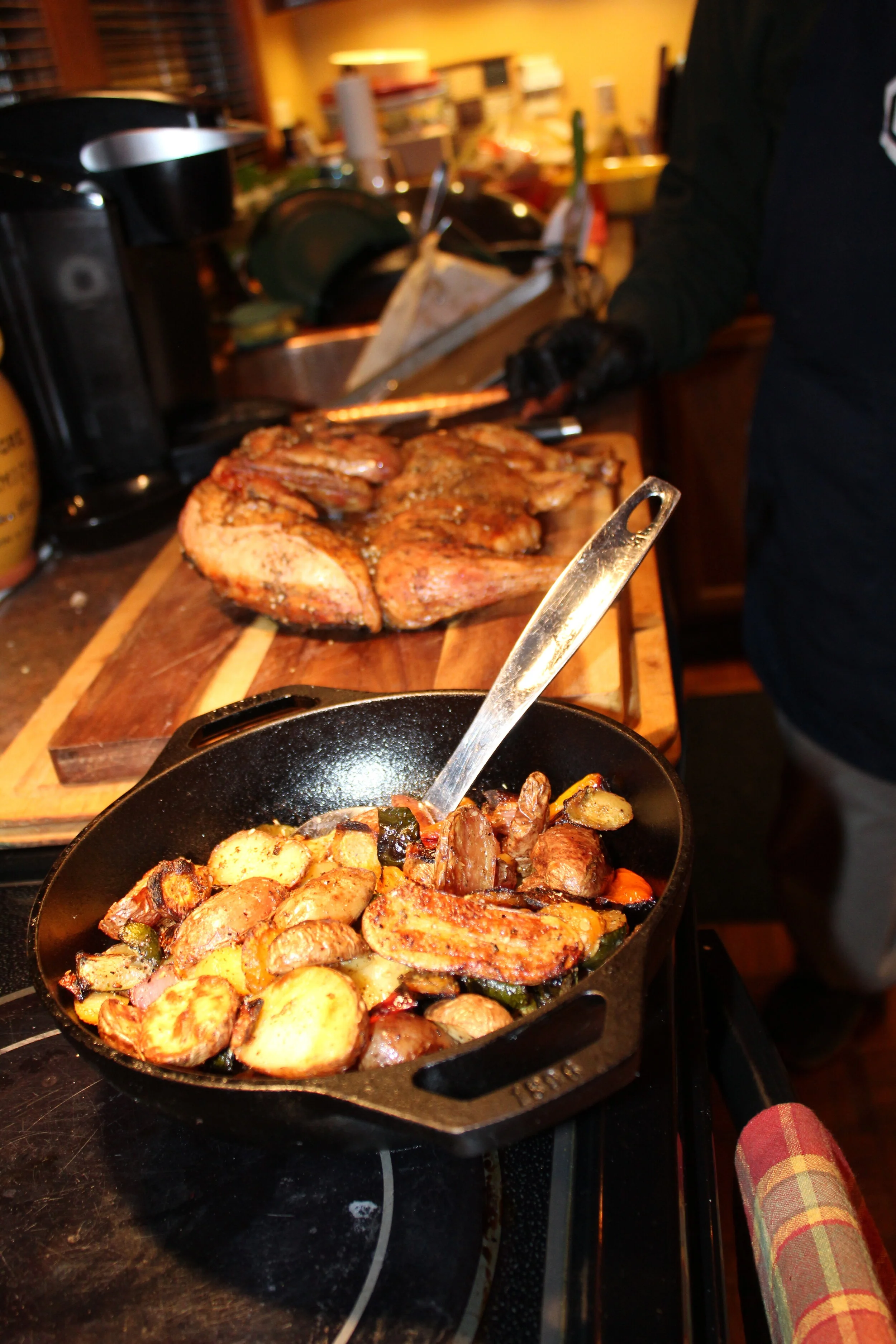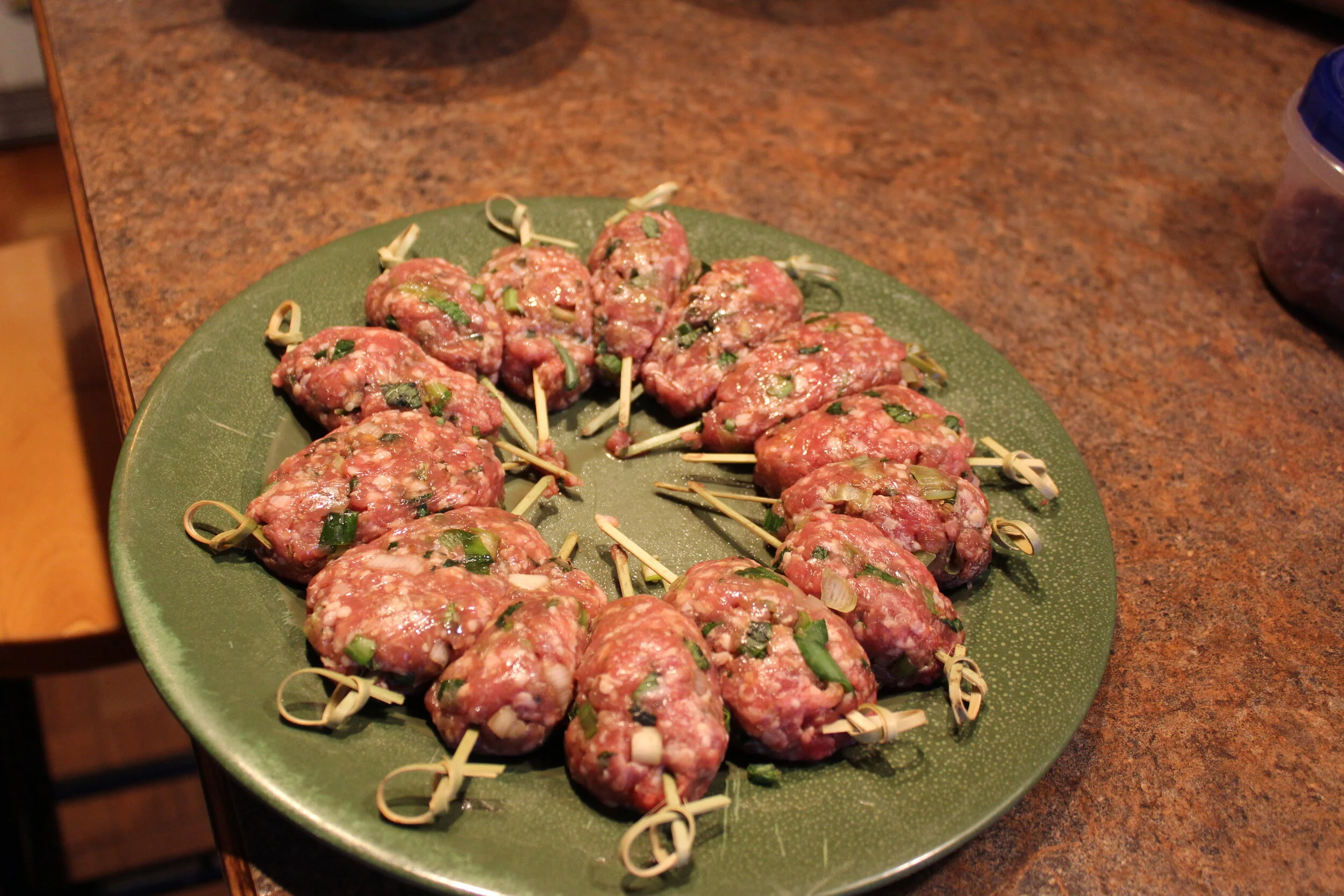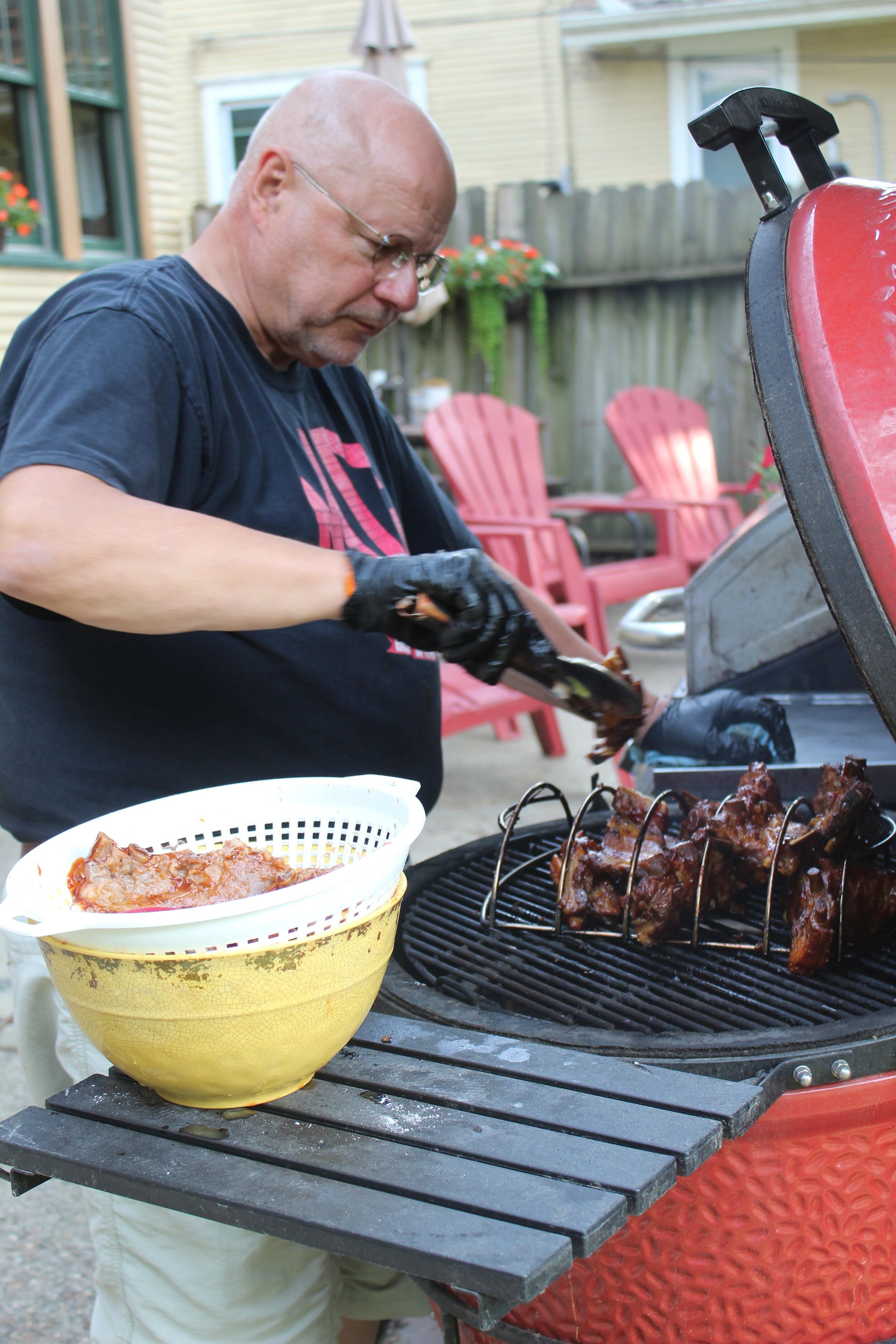Locally Grown Meal - Spatchcock Chicken and Roasted Veggies
To watch Leon tend to our Locally Grown Meal has been a sight to behold.
He tinkered with the grill to make sure it was at the right temperature and he had, before I even arrived for the first course of tea (or coffee) and crumpets, prepped all the vegetables for roasting. No moss grows under his feet! Leon has monitored it all and kept his same easy going demeanor.
How does he do it?
He has planned.
Leon has a wealth of recipe books and, knowing what foods I would be bringing for him to prepare plus what he had available in his own pantry, he planned for the meal.
Since we’ve covered the tea (0r coffee) and crumpets plus appetizers of lamb meatballs and chicken liver pate, we move on to the main course!
But first, the veggies
The vegetables were purchased from Ida Valley Farm. Jeff and Jane Way not only have garden plots, but also high tunnels. This Garfield, MN couple raise micro greens throughout the year, seling the greens to restaurants during the winter and to Alexandria, MN Farmers Market customers during the market season.
Their garden produce is also a big seller at the market and their root vegetables are available throughout the winter season.
For our Local Growers Meal, I purchased rainbow carrots and French fingerling potatoes. I also bought their micro greens which Leon topped on a lettuce salad. Of note here: The micro greens I received were a mild flavored micro green and quite tasty. I have used it on sandwiches as well as salads. During the summer I purchased a spicy micro green mix which I also enjoyed. It is as the name says, a bit spicy, and gives a great zip to the sandwiches and salads.
For our meal, Leon cut the potatoes and rainbow carrot into even pieces. (The rainbow carrots weren’t skinny minnies. These were good sized carrots and quite tasty). He added some peppers, zucchini and other veggies he had on hand to the roasted vegetable mix.
When I talked to Jeff and Jane Way about root vegetables, here were some of their storage tips.
The Ways harvest the root vegetables in the fall and store them in their walk-in cooler through the winter. They use the milk heater to maintain temperatures in the 30s and 40s. Carrots are stored in plastic bags with ventilation.
At the end of their Farmers Market season, they collect an e-mail list of customers and make weekly deliveries through late December to early January.
I called them mid-January to check on availability of root vegetables, which they obviously had, and made arrangements from there for a payment and pick up. I contacted them through their Ida Valley Farm Facebook page. Check it out!
If you do make a bulk purchase of root vegetables at the end of the season, the Ways have some suggestions on storage.
Carrots can be stored in a plastic bag and put in the refrigerator, they said. Potatoes should be stored in a cold, dark room in the basement. If potatoes are in a pantry or warmer room, the potatoes will most likely start to sprout. If that happens, they say just break off the sprouts to keep the potatoes firm.
For beets and turnips, store them like carrots. Onions to best in a cooler room and not in the refrigerator. Onions don’t store well in humid conditions, they said.
Roasting vegetables
Leon writes about the roasting process, “I used small fingerling potatoes cut just in half. We also had rainbow carrots cut into small pieces. I used zucchini (with the center seeds scooped out) and then cut into 3/4 inch chunks. I added cut up yellow onion pieces to the mix.
“To marinate, I used a gallon zip-lock baggie with all the vegetables on another mix of olive oil and about a tablespoon of Zaatar spice.
“Just simple salt and pepper will work fine too. Shake the bag and let mix and marinate for about a half hour. Spread the now seasoned vegetables on a high rimmed baking sheet on foil or, I prefer, parchment paper, as it seems to soak up some of the excess oil. Bake in the middle rack of the oven at 400 degrees F for about 30 minutes. When you can easily pierce the carrots with a fork, the potatoes and zucchini will be done as well.
I like the veggies to be a bit browned and crisp. You can achieve this by not crowding the vegetables on the pan. If needed, use two pans”.
Leon notes that the rainbow carrots with the green zucchini made for a nice presentation for the table.
And the Zaatar seasoning? It’s a Lebanese seasoning. While it’s not hot like some Mexican spices, it does have a robust flavoring.
Then theres the chicken!
Spatchcock anyone?
Leon said spatchcocking is a great way to speed up the grilling time when making a whole chicken. The chicken was about 5 pounds which is a nice size for 4 to 5 people.
Oh, and that 5 pound bird? That is the true weight of the chicken. Heritage Acres, where I ordered the meat, said they do not put the gizzard or hearts back into the bird before its packaged and frozen. Other large meat companies will and will charge for that combined weight of the bird and gizzard. But if you don’t use the gizzard, you are paying for something you are not using.
If you want the gizzard and heart, it can be purchased separately on their website’s online store at heritageacresmn.com.
To spatchcock:
This process involves one cut on the breast side of the chicken. Cut as close to the center as possible all the way to the backbone. Then flip the bird over while flat on the cutting board. Press firmly with the palm of your hand until you flatten the chicken out. Leon usually pins the wings tight to the main body with a toothpick or short skewer.
His next step is to season the bird. He used a mix of olive oil and Zaatar, the Lebonese spice blend. He made about 3/4 of a cup of this olive oil-Zaatar blend. He first basted the bird with about 1/4 cup of the mixture using a basting brush. The remainder, 1/2 cup, he used to baste the bird on the grill. More on that in the grilling process instructions.
Now, off to the grill!
Leon uses an egg type grill and brings the temperature up to 400 degrees F to start heating the bottom side first for about 25 minutes. Baste once again then flip over and cook on the skin side for another 30 mintues until the internal temperature reads 175 degrees in the thigh and no less than 165 in the breast meat.
Be careful not to overcook as this will result in less moist meat. During the last half hour of the cook, baste every 10 mintue or so, if possible. When its up to temperature, let the chicken rest for about 10 mintues before serving.
Any chicken, small turkey, or game hen will work, but be sure to adjust the cook time according to the side. Leon says he finds this also gives just a little different presentation of the traditional roasted chicken.
To the table….
If you ever have the opportunity to have a meal at the Dawkins’ house, you will be treated to a special time for sure! They make it seem so effortless.
The atmosphere was welcoming and warm (and not just because of the logs burning in the fireplace) and the table set. The food was great and flavorful. The chicken was moist and the vegetables had that crispness that Leon strives to bring to the dish.
We also had dessert prepared by Emily of Sugar High Bakery and Confections. Emily’s story will appear soon.
If you have any comments or questions, please share in the comment section below. We look forward to your feedback on this special series and are discussing another in the near future.











